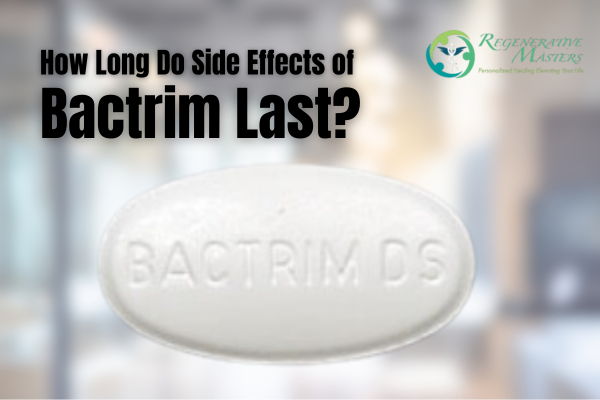If you’ve recently been prescribed Bactrim, a commonly prescribed antibiotic, you might be wondering about potential side effects and how long do side effects of Bactrim last. It’s crucial to be well informed to manage any discomfort effectively.
Bactrim, comprising trimethoprim and sulfamethoxazole, is an antibiotic designed to combat bacterial infections. While effective in treating infections, it comes with potential side effects.
The severity of these side effects can vary, prompting some individuals to consider discontinuing the medication after consulting their doctor. However, it’s important to note that side effects may not be resolved until Bactrim has completely exited your system.
What is Bactrim?
Bactrim, a combination of sulfamethoxazole and trimethoprim, is a powerful antibiotic that tackles various bacterial infections. Administered every twelve hours, the treatment duration ranges from 3 to 14 days, depending on the severity of the infection. Bactrim DS, available in double-strength tablets, offers an intensified dosage. Overall, Bactrim provides effective, adaptable care by disrupting crucial bacterial processes.
What are the Side Effects of Bactrim?
As with many antibiotics, Bactrim may induce a range of side effects, with stomach upset taking center stage. Diarrhea, in particular, stands out as a common side effect, often accompanied by feelings of nausea, vomiting, or diminished appetite.
In addition to gastrointestinal effects, Bactrim has the potential to heighten your skin’s sensitivity to sunlight. This increased sensitivity may lead to a heightened risk of sunburn. To mitigate this risk, it is advisable to don protective clothing when venturing outdoors, diligently apply sunscreen, and, when feasible, steer clear of direct sunlight or tanning beds.
It’s imperative to be aware that certain individuals may exhibit an allergic response to Bactrim. Symptoms of an allergic reaction include persistent coughing, the appearance of hives, difficulty breathing, chest pain, or swelling in the face or throat. If any of these signs appear, it is crucial to seek prompt medical attention.
Furthermore, Bactrim carries the potential for triggering a severe skin reaction, marked by symptoms such as a sore throat, fever, skin pain, burning eyes, or the development of a purple or red rash accompanied by peeling skin and blisters. Prompt medical attention is strongly advised if you observe any of these symptoms.
So, How Long Do the Side Effects of Bactrim Last?
Recognizing that Bactrim may linger in your system for approximately five days, with some variability, it’s natural to inquire about the duration of Bactrim’s side effects post-cessation or completion of your treatment course.
Generally, Bactrim’s side effects tend to ameliorate within a few days to a week after discontinuation. The timeline, however, is contingent on several factors, including your overall health, the specific side effects encountered, and the dosage administered during treatment.
When dissecting individual side effects, nausea and vomiting typically subside within a few days. Taking Bactrim with food can expedite relief from these symptoms. Notably, these side effects commonly resolve promptly once Bactrim is discontinued.
Conversely, some side effects may persist for a more extended period. Take, for instance, a skin rash induced by Bactrim. The duration of this side effect can fluctuate, influenced by factors like the rash’s severity and underlying cause.
While the general trajectory suggests a rapid improvement in side effects after stopping Bactrim, the unique interplay of variables in each individual’s case necessitates a nuanced understanding. Monitoring your specific symptoms and, when necessary, seeking guidance from your healthcare provider ensures a comprehensive approach to managing and understanding the duration of Bactrim’s side effects tailored to your health profile.
Conclusion
The duration of Bactrim side effects can vary, but in most cases, they are temporary and should improve within a week. Remember, your health is a priority, and your healthcare provider is your best resource for guidance and support. If you have questions or experience problematic side effects, don’t hesitate to ask for professional advice.
FAQs
How do you flush Bactrim out of your system?
To flush Bactrim out of your system, stay hydrated by drinking plenty of water. This helps speed up the elimination process through urine. Consider consulting a healthcare professional for personalized advice. Additionally, maintaining a healthy diet and engaging in physical activity can support the natural detoxification of your body.
How long does it take to feel better after taking Bactrim?
Bactrim functions by eradicating bacteria. It can start killing germs within one to four hours after consumption, demonstrating its rapid efficacy. In light of this, you could get remission from infections like a UTI in a few days. On the other hand, it might take a few weeks to notice an improvement from more severe diseases like pneumonia.
How much water should you drink while taking Bactrim?
As you are taking this medication, sip more water. Adults should consume six to eight cups (48 to 64 ounces) of water daily while taking Bactrim.

